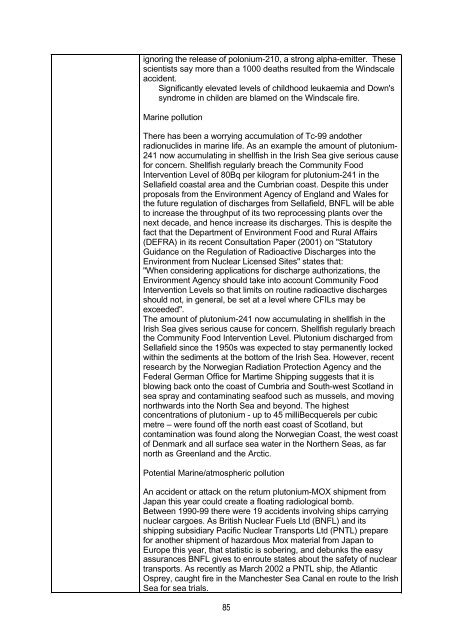Umweltverbrechen multinationaler Konzerne - Greenpeace
Umweltverbrechen multinationaler Konzerne - Greenpeace
Umweltverbrechen multinationaler Konzerne - Greenpeace
Erfolgreiche ePaper selbst erstellen
Machen Sie aus Ihren PDF Publikationen ein blätterbares Flipbook mit unserer einzigartigen Google optimierten e-Paper Software.
ignoring the release of polonium-210, a strong alpha-emitter. These<br />
scientists say more than a 1000 deaths resulted from the Windscale<br />
accident.<br />
Significantly elevated levels of childhood leukaemia and Down's<br />
syndrome in childen are blamed on the Windscale fire.<br />
Marine pollution<br />
There has been a worrying accumulation of Tc-99 andother<br />
radionuclides in marine life. As an example the amount of plutonium-<br />
241 now accumulating in shellfish in the Irish Sea give serious cause<br />
for concern. Shellfish regularly breach the Community Food<br />
Intervention Level of 80Bq per kilogram for plutonium-241 in the<br />
Sellafield coastal area and the Cumbrian coast. Despite this under<br />
proposals from the Environment Agency of England and Wales for<br />
the future regulation of discharges from Sellafield, BNFL will be able<br />
to increase the throughput of its two reprocessing plants over the<br />
next decade, and hence increase its discharges. This is despite the<br />
fact that the Department of Environment Food and Rural Affairs<br />
(DEFRA) in its recent Consultation Paper (2001) on "Statutory<br />
Guidance on the Regulation of Radioactive Discharges into the<br />
Environment from Nuclear Licensed Sites" states that:<br />
"When considering applications for discharge authorizations, the<br />
Environment Agency should take into account Community Food<br />
Intervention Levels so that limits on routine radioactive discharges<br />
should not, in general, be set at a level where CFILs may be<br />
exceeded".<br />
The amount of plutonium-241 now accumulating in shellfish in the<br />
Irish Sea gives serious cause for concern. Shellfish regularly breach<br />
the Community Food Intervention Level. Plutonium discharged from<br />
Sellafield since the 1950s was expected to stay permanently locked<br />
within the sediments at the bottom of the Irish Sea. However, recent<br />
research by the Norwegian Radiation Protection Agency and the<br />
Federal German Office for Martime Shipping suggests that it is<br />
blowing back onto the coast of Cumbria and South-west Scotland in<br />
sea spray and contaminating seafood such as mussels, and moving<br />
northwards into the North Sea and beyond. The highest<br />
concentrations of plutonium - up to 45 milliBecquerels per cubic<br />
metre – were found off the north east coast of Scotland, but<br />
contamination was found along the Norwegian Coast, the west coast<br />
of Denmark and all surface sea water in the Northern Seas, as far<br />
north as Greenland and the Arctic.<br />
Potential Marine/atmospheric pollution<br />
An accident or attack on the return plutonium-MOX shipment from<br />
Japan this year could create a floating radiological bomb.<br />
Between 1990-99 there were 19 accidents involving ships carrying<br />
nuclear cargoes. As British Nuclear Fuels Ltd (BNFL) and its<br />
shipping subsidiary Pacific Nuclear Transports Ltd (PNTL) prepare<br />
for another shipment of hazardous Mox material from Japan to<br />
Europe this year, that statistic is sobering, and debunks the easy<br />
assurances BNFL gives to enroute states about the safety of nuclear<br />
transports. As recently as March 2002 a PNTL ship, the Atlantic<br />
Osprey, caught fire in the Manchester Sea Canal en route to the Irish<br />
Sea for sea trials.<br />
85

















